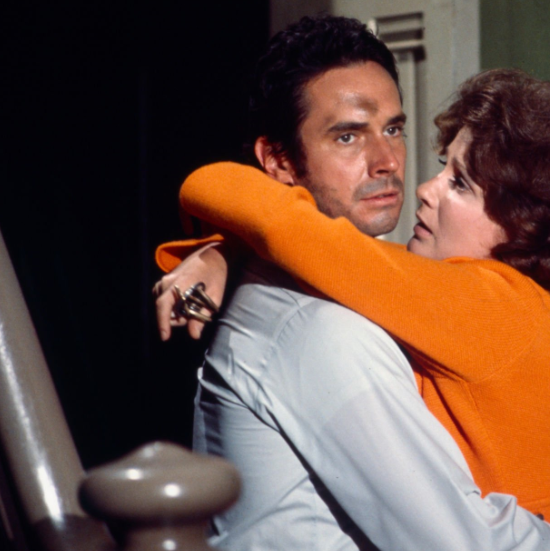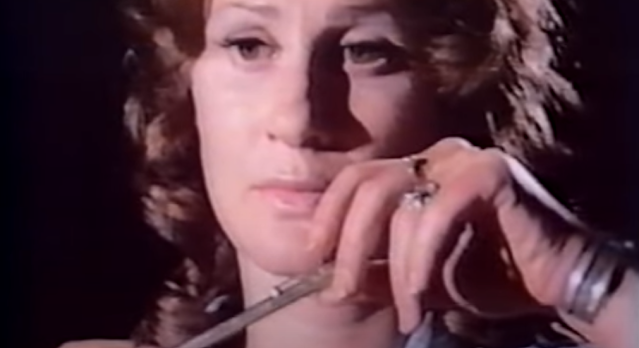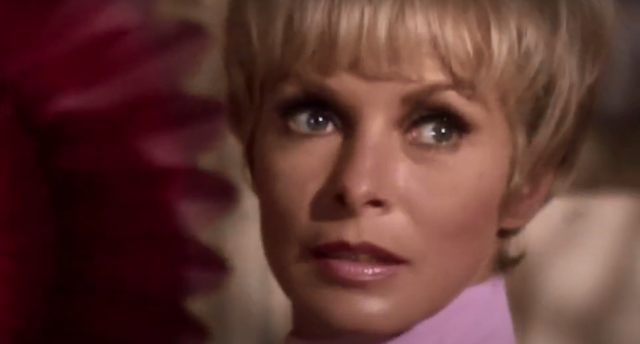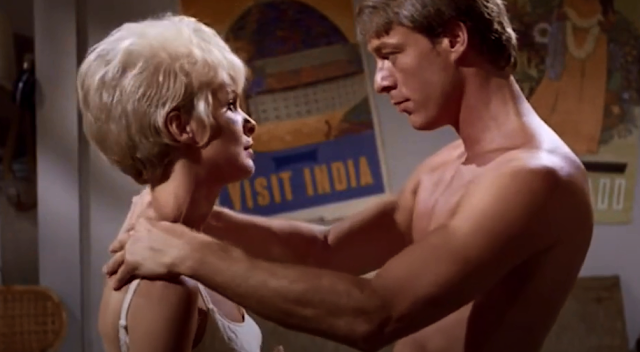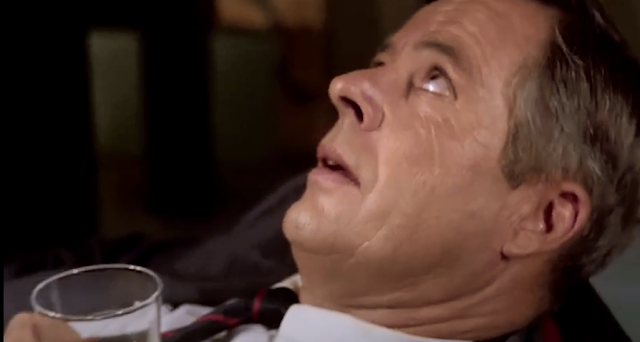 |
| "Wait Until Dark" a 1967 suspense film written by Frederick Knott, also had a stage and film hit with "Dial M For Murder." With Alan Arkin & Audrey Hepburn. |
If Wait Until Dark was ever remade, it’d have to be done as a period piece.
***Spoiler alerts are discussed throughout this review***
Though there are
clever reasons for the villains' actions and plot twists (to show how
resourceful the blind heroine is, while tormenting her needlessly), those plot
points don't always add up. Alfred Hitchcock never got hung up on plots making
perfect sense, as he relied on suspension of disbelief in service of thrills.
This is all well and good, though some of Hitch’s lesser sleights of hand were
audience head-scratchers.
 |
| The film version of "Wait Until Dark" was a big hit in '67. |
Adapted from the 1966
Broadway hit, Frederick Knott’s Wait
Until Dark up close and personal film version shows the plot strings being
pulled too obviously. Unlike Gaslight,
another woman in distress stage play turned movie, there's no character depth
beneath the chills. Watching the heroine's character trajectory in Gaslight works on several levels; in Wait Until Dark, the blind heroine
proves resourceful in the face of danger, and presented heavy-handedly. The
movie is well-acted enough so that you become invested in the characters.
The plot of Wait Until Dark is a bit convoluted, but
in a nutshell: A young woman, Lisa, runs drugs via a heroin-filled doll.
Startled by the villain she sees at the airport, she gives the doll to stranger
Sam Hendrix, to be collected later. She's intercepted by the movie's psycho,
Harry Roat. And that's all she wrote!
Roat lures two small time criminals to the Hendrix apartment and coerces them
into shaking down the Hendrix couple to retrieve the doll. Sam thinks it's just
a doll and he's away; wife Susy is totally in the dark—figuratively and
literally—she’s blind. Roat engineers an elaborate gaslight on Susy to get the
valuable doll. Game on!
 |
| Richard Crenna as Mike discovers Lisa, who discovered stealing drugs doesn't pay, in 1967's "Wait Until Dark." |
On the plus side, the set-up
is clever and cast is first-class. On the minus side, there are a number of
plot holes. If this movie had more depth of character and plot development, I
would not have focused on the deficiencies. But when the characters and logic are
as slim as Audrey's figure, the mind wanders.
The big one: Roat's
psychopathic villain visits Susy in several elaborate character disguises to
find the doll. Why? Susy's BLIND!
 |
| "Nice disguise there, evil genius. Spoiler alert, I'm blind!" 1967's "Wait Until Dark." |
The second big one:
When Susy catches on to the thug trio's ruse, she enlists neighbor girl Gloria
to go to the bus station to get husband Sam home to the rescue. There's a very
patronizing undertone to Sam wanting Susy to be more independent after her
recent accident-caused blindness. Susy’s rationale that "Sam will know what
to do" rings very false. You send three killers looking for drugs on a
fool’s errand, they are coming back to kill you, and you send a kid on a
mission to the bus station, when she could just go upstairs and call the
police?
 |
| Audrey Hepburn & Julie Herrod have a nice camaraderie as blind Susie Hendrix and neglected upstairs girl, Gloria, in "Wait Until Dark." |
And the third big one:
Once Susy has the doll, why doesn’t she just give it to them? She was scared
when she heard about the woman (Lisa) found murdered a block away. Now she
knows they killed “Mrs. Roat,” does she want to be next?
 |
| Once Susy has the drug doll in her possession, why won't she turn it over? |
Also, during the final
black-out confrontation with killer Roat, he tells her game over as she tries
to escape from her chained front door and he's found a light. Why? She still
has a knife and matches, and he's still soaked in gasoline.
Of course, it would be
hard to film this movie in present day without major changes: the drug runner getting
the doll through security no problem; the two ex-cons making themselves at home
in the Hendrix apartment, leaving their DNA everywhere; and today, the three
criminals would just get down to business and torture and kill the heroine until
they got the doll. This is just for starters.
 |
| Audrey Hepburn is ideally cast as a sympathetic blind woman tormented in "Wait Until Dark." Also in '67, Audrey made one of her best, "Two For the Road." |
As a popcorn suspense
film there are certainly some very clever twists and characterizations. Audrey
Hepburn is a natural as Susy Hendrix, the self-described world champion blind
lady. Empathy and warmth was the essence of Hepburn's persona. Hepburn plays
the character strongly without overplaying and it is a stellar movie star
performance. It's noteworthy that Audrey got the film's lone Oscar nomination. She makes you root for and believe in her, though the movie still
has a foot in the studio era style: Audrey's Susy just may be the most stylish
blind woman in the world. The thought of a blind woman with big false eyelashes
made me smile. She even changes clothes in the middle of the movie, for no
apparent reason. Also, Audrey gets lovely soft focus close-ups. Wait Until Dark makes this movie more of
a throwback to classic ‘50s Hitchcock than a gritty late '60s thriller.
Speaking of Hitch, I'm surprised nobody tapped him to do this film. He nearly
worked with Audrey before, and also filmed the playwright's Dial M For Murder to great effect. But
Terence Young does a solid job here and does the best he can with what was
basically a one-set stage piece.
 |
| Audrey Hepburn as Susy Hendrix, a woman recently blinded, in "Wait Until Dark." |
Lee Remick played Susy
on Broadway to Robert Duvall's Harry Roat. I bet that was something to see. And
though I'm sure Lee was just as good as Audrey, Remick was a leading lady who
never carried a movie, where Hepburn was one of the few female stars of the
‘60s who could.
Not having seen this
in a number of years, I had forgotten how good Richard Crenna was as
"Mike," the criminal pretending to be Sam's old war buddy. He offers
what may be the most complex character. A con and crook, yes, but he's also
taken by Susy's tenacity. He's the bad guy, but you want to like him! Jack
Weston is good as the lowest functioning bad guy, Carlino, a bit of comic relief.
 |
| Jack Weston and Richard Crenna as two ex-cons coerced into retrieving a drug doll, in 1967's "Wait Until Dark." |
Alan Arkin has the
showiest role as Harry Roat. I found him more interesting as the creepy
criminal himself than in his various disguises. Humorous, creepy, sly and when
he goes one on one with Susy, it's the hair-raising highlight of the film. The
last set piece is very well done and I've heard many stories about how
audiences in the dark involuntarily gasped and shrieked as Arkin's Roat goes
after Hepburn's Susy.
 |
| Alan Arkin as the twisted, darkly humorous villain Harry Roat, in "Wait Until Dark." |
One plot element and
acting I found a bit smarmy: Sam Hendrix, the character and Efrem Zimbalist,
Jr., the actor. Given the fact his wife has been blind just a year, his tough
love bit feels a bit like a husbandly bully, insisting that she "do"
for herself. When Sam and the cops finally rescue her, they step over dead
bodies, a trashed, gasoline-soaked apartment, and find a hiding Hepburn as Susy
behind the fridge door. And Zimbalist's smiling Sam urges her to come to him! I
wonder if a blind wife could kick her husband in the balls? And Zimbalist's
acting is old-school Ronald Reagan variety, like a charming TV host, complete
with a Hollywood tan—while playing a New Yorker.
 |
| Efrem Zimbalist, Jr. is Sam Hendrix, the photographer husband of blind Susy. |
Julie
Herrod as Gloria, the young girl upstairs, is natural, quirky, and appealing. She
also played the character onstage with Lee Remick. Lisa, the doomed drug runner
looks like a refugee from Valley of the
Dolls, with the most obvious fall, and a more deadly doll than pills! Her
stage name is Samantha Jones, which was later used as Kim Cattrall’s character
in Sex in the City!
 |
| Samantha Jones is Lisa, a drug runner who looks like a runner-up for "Valley of the Dolls," complete with a fall and false eyelashes. Instead of "dolls," this doll has heroin! |
The score by Henry Mancini
is expertly eerie and the natural NYC location shooting gives this glossy
thriller some needed grit.
Don't get me wrong, Wait Until Dark is still a fun thrill
ride. Just don't look too closely at the story behind a blind woman's long night
from hell.
 |
| Despite some serious gaps in logic, you'll be gasping in shock in the last act of "Wait Until Dark." |




















